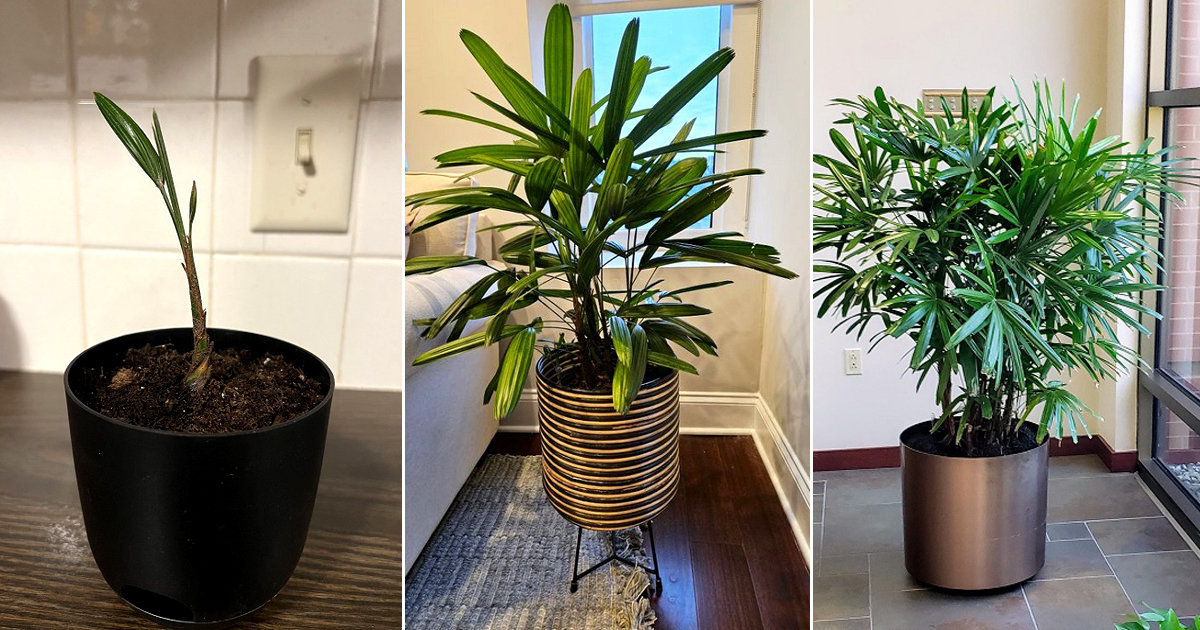If you want to bring a lush tropical look to your rooms then read ahead to learn How to Grow Lady Palm Indoors and add beauty to the space!
Rhapis excelsa has a reputation for being able to fit with most of the interiors in homes and is also quite easy to look after. If you, too, want it to adorn the space, then here’s all you need to know about How to Grow Lady Palm Indoors!
Common Names: Bamboo Palm, Broadleaf Lady Palm, Fan Tufted Palm
Best Lady Palm Varieties
These are some of the best varieties of Lady Palm that you can grow indoors:
- Koban: With notably huge leaf segments and a tendency to spread outward, it is one of the good choices for a houseplant.
- Daruma: With narrow leaves and an upright growing habit, Daruma is another excellent variety of Lady palms that can be grown indoors.
- Tenzan: The foliage of this plant has a tendency to curl up a bit, and it is one of the fastest-growing varieties.
- Kodaruma: It has a particularly slow growth rate, and it is one of the miniature varieties.
- Zuikonishiki: Another small houseplant variety that features white and green striped leaves.
Best Pot Size to Grow Grow Lady Palm
The pot size depends on how big or small the plant is. If you are getting it from a nursery, it is advisable to transplant the plant into one size bigger container. The key here is that the pot size should always be one size bigger than the root ball of the plant.
How to Grow Lady Palm Indoors

Propagating Lady Palm is a fairly easy process and can be done via divisions. Growing it from seeds will take a lot of time, so doing it with divisions and pups is the most sensible way.
Select a healthy plant and take it out carefully from the pot. If it is slightly root bound, breaking the pot will ease out the process.
After snipping the excess roots, you will be able to see many young plants in the clump. Remove them carefully using a shear. Do make sure to include the roots.
That’s it! You are done. You can now plant them in pots filled with a fresh potting mix.
Water well and place them at a location where they can get bright light for 2-3 hours.
Lady Palm Growing Requirements

Location
Choose a location that receives indirect sunlight – an east-facing window would be a great place. Avoid keeping the plant near a south-facing window as the constant exposure to harsh afternoon sun may burn the foliage. Avoid keeping the plant in a shady and dark location.
Soil
Well-drained, loamy soil is the best for Lady Palms. You can also go for any well-draining pre mix. Alternatively, you can mix two parts of regular potting soil, one part sand, half part compost, and half part coconut coir. If you want to know how to DIY it at home, we have a detailed article on it here.
Water
This plant is tolerant to drought-like conditions once they are established completely. It would be wise to water the plant only water when the topsoil feels dry to the touch. Avoid wetting the foliage.
Temperature and Humidity
Please ensure that the palms remain in a room where the temperatures are maintained at above 55°F or 12°C as anything colder than this point can cause serious damage to the plant.
Lady Palms love a humidity level of 50 percent or higher. Place the pot on a pebble tray filled with water or use a humidifier.
Lady Palm Care

Fertilization
Use a diluted water-soluble feed like 10-10-10 once in 8-10 weeks during spring and summer. Avoid feeding the plant in winters. If the plant is battling magnesium deficiency, Epsom salt is also a good choice.
Pruning
As the plant is a slow grower, you don’t have to prune it much. Snip away older, brown leaves using shears. Make sure not to harm the plant.
Re-Potting
Keeping the plant in a slightly root-bound state will limit its size. However, the plant will need to be re-potted every 2-3 years. Go for a pot that’s one size bigger than the old one and use a fresh growing medium.
Pests and Diseases
Be careful of red spider mites, whitefly, scales, and mealybugs. Use a strong jet of water or insecticidal soap to take care of them.
Avoid overwatering the plant to save it from root rot.









